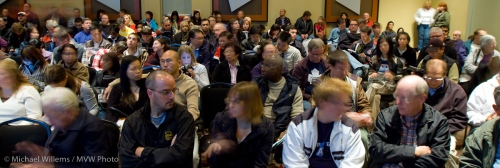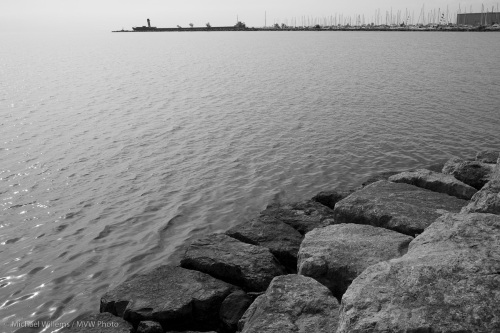I am not sure if this means anything, but since upgrading my Canon 7D to firmware 1.09, it has not hung up (frozen) again. Fingers crossed!
Monthly Archives: October 2009
Self portrait
How do I take one of these with my new 7D?
I set the camera on a tripod and use pocketwizards to fire one flash into an umbrella. One flash gives me that severe look, but to slightly lessen that, I have a reflector on the other side (camera left). I used a 35mm f/1.4L lens on the 7D, meaning an effective lens length of about 50mm. The “Nifty fifty”!
I set my camera to 100 ISO – best quality, and background light does not upset the shot. And I am in manual mode, at f/8 (enough DOF) and 1/125th second. I use autofocus where the camera selects a focus point, This time. I will – because as the subject I cannot see what I am doing.
Finally, I use the timer of course. So I can press the shutter while I hold my hand out; then sit down as the camera beeps.
And then I check: sharp enough? Nice graduated tones from dark to light? Catchlights in the eyes? Check!
I'm a sharp freak.
Here I stand before you: I cannot deny it. I like sharp. Really sharp.
So when I go do some street shots, such as this portrait I shot outdoors after I shot a bookstore yesterday, I am delighted when the 7D, equipped with the 35mm f/1.4 lens, gives me this (and you should click and then view it at original size: don’t let your PC or Mac downsize it):
That’s what a good camera and a good lens does. And shooting that street stuff yesterday, I was impressed with how sharp the focus is in most of my images – the focus system really is better tan that on my 1Ds3/1D3. Here’s another example:
Nice car.
Landscaper tips
Today, a few quick tips for shooting landscapes.
Follow these:
Tools:
- Use a tripod. This is the one time you will need one. Landscape needs to be sharp. SHARP.
- Consider using graduated filters to darken skies.
- Consider using a polarizing filter.
- Use small depth of field (e.g. set an aperture of f/11 or f/16).
- Focus one third into the picture to ensure all is sharp.
- Be careful not to over-expose. You may well need -1 stop exposure compensation when shooting foliage.
- Did I mention tripods?
Composition:
- Keep the horizon straight.
- Shoot at sunrise or sunset if you can.
- Use the “rule of thirds”.
- Use S-curves if you can to gently lead into the image.
- Look for small colour contrasts (e.g. red-green, and yellow-blue),
- Consider adding close-by foreground subjects to show depth in your image.
And your pictures will be better!
Book snap.
Update
Canon 7D firmware update!
http://web.canon.jp/imaging/eosd/firm-e/eos7d/firmware.html
Why oh why..
…are studio flash pictures so much sharper than available light pictures? Like, always?
Whatever you do, available light may look great – but when you zoom in close, it is not perfect.
Studio is much better. Look at this picture I just took with my Canon 7D at f/11, 1/125th sec, 100 ISO, using two studio strobes driven by a pair of Pocketwizards:
Zoom in and it is spectacular. This is the original size (once you click), and utterly unaltered:
Why is this so much better?
Let me tell you some differences. I count six:
- Aperture – Studio light means f/8. Available light means f/2.8. Lenses are typically sharper and clearer at f/5.6-f/8.
- ISO – Available light means higher ISO. Lower ISO, like in a studio, means sharper pictures.
- Shutter speed – Flash is around 1/1000th second. Available light pictures, even at 1/250th second, will not be as clear.
- Tripod – In a studio you are likely to be using a tripod. This is huge, in terms of focus and motion.
- Light direction – Studio flash is directional. Available light is diffuse. So surfaces look clearer.
- Exposure – In a studio, you are likely to expose to the right – the pixels will be bright pixels. Bright pixels are sharp pixels!
So it is not so much one factor. It is the combination of all of them. In a studio you have all of them your way; in available light, many, sometimes all, are not ideal. That is why studio flash is so much crisper.
Have I left anything out, anyone?
Love it
If there is one thing in life I do well, it is to make complicated things simple. Customers and listeners appreciate this. Today was no exception: on the last day of the photo show, I spoke to another 1,500 people, I estimate. That means that over the three days I am sure I addressed 5,000 people.
This busy show emphasises how much people want to learn about photography and equip themselves with the right equipment.
After my presentations, there are lineups to sign up for the workshops. After all, they are tremendous fun, and when you do a workshop, it is amazing how much more you get out of your camera.
Just like pixels were born to be punished, I was born to do this, I think. What a blast, to help people understand their cameras and to help them make great pictures.
I met so many wonderful people – some of whom I have met many times. Some (like Maged Henein ) are great photographers. Many have interesting stories (like the young lady who wants to be a war photographer – oh boy do I recognise myself at that age!). Many who are getting into photography again after a hiatus. And all of them share a love of photography that I have too – a love that makes this field so exciting.
Those of you here checking out my blog because you were part of those people, please do leave comments and ask questions: I’ll even answer them online if they are interesting to others.
And: thank you!
Michael
Black and white
…and grey. Underrated, as said before, Here’s a recent snap of the day.
My advice to all of you is to do more black and white photography. Ideally, shoot in RAW (but preview in B&W on your camera) and use Lightroom (or if you must, Photoshop) to intelligently convert the images. Some will work; others will not; and you will learn from this process. As I do, every day.
More crowds
So today I addressed at least several thousand people. These are the kinds of standing-room-only crowds I love:
And I thrive in this, witness this picture taken by my friend, Oakville photographer Dani:
Today’s subjects included Travel Photography, Introduction to your DSLR, Lightroom and RAW, and Composition. More tomorrow! And hopefully, more wonderful crowds like this:

One more day – don’t miss it.
In walking the show, I was struck by two examples of customer service.
On the one hand, Gary Fong. Yes, that Gary – the maker of the Lightsphere. He chatted with me, we exchanged business cards and he was genuinely interested in my suggestions and feedback. He even snapped my picture. Hats off to Gary.
On the other hand, Apple. At the Apple booth I mentioned that I had left Aperture, which crashed, for Lightroom. Because, as said, Aperture crashed. As soon as I said this, the Apple guy promptly turned away and.. well, sneered. An Apple fanboi also at the booth asked the Apple employee “Crashed? What was he talking about?”. “Huh. Your guess is as good as mine”, shrugged Apple guy to Apple fan. “In fact it’s probably better”. Both turned away from me both laughed (no – sneered), and neither looked at me again.
This kind of appalling service is, I suppose, OK if you are Apple, but I cannot imagine it can do you much good in the long run. For a start, it leads to blog posts such as this one. Love Apple products, but the company… wow. Sneering at your customers for daring to say something that might imply that your Holy Product is not, like, perfect. Wow. I feel like I was… excommunicated.. what is it the Amish do when you are cast out from the tribe? These guys make Rogers look good!














